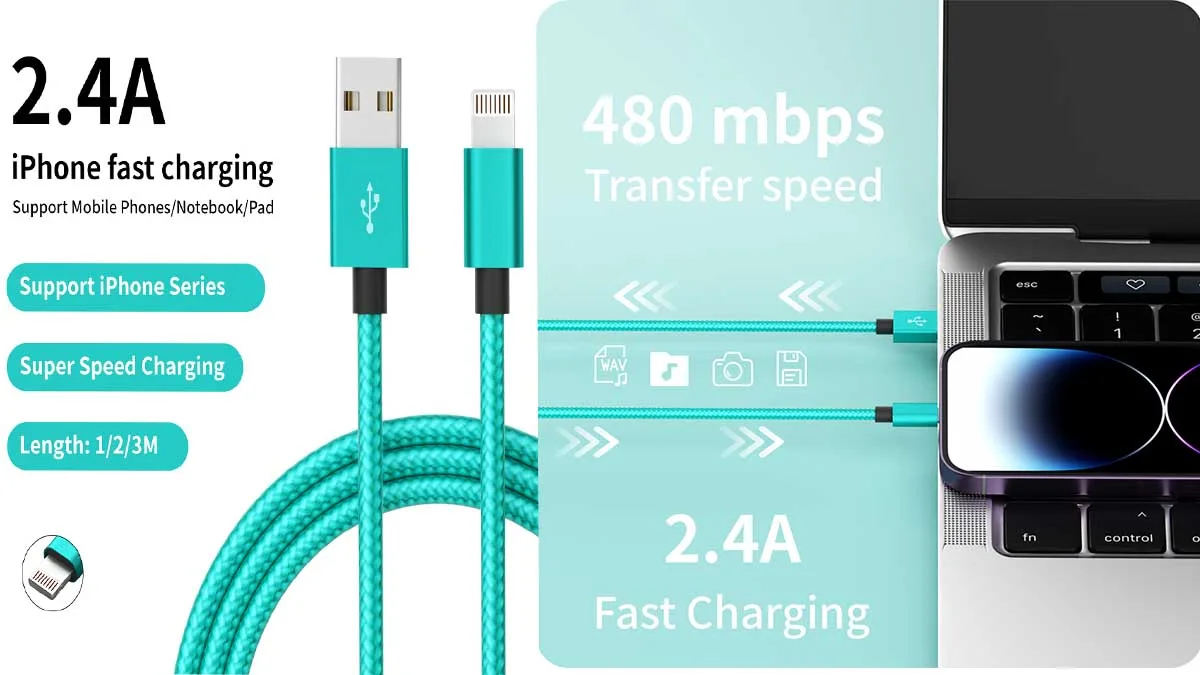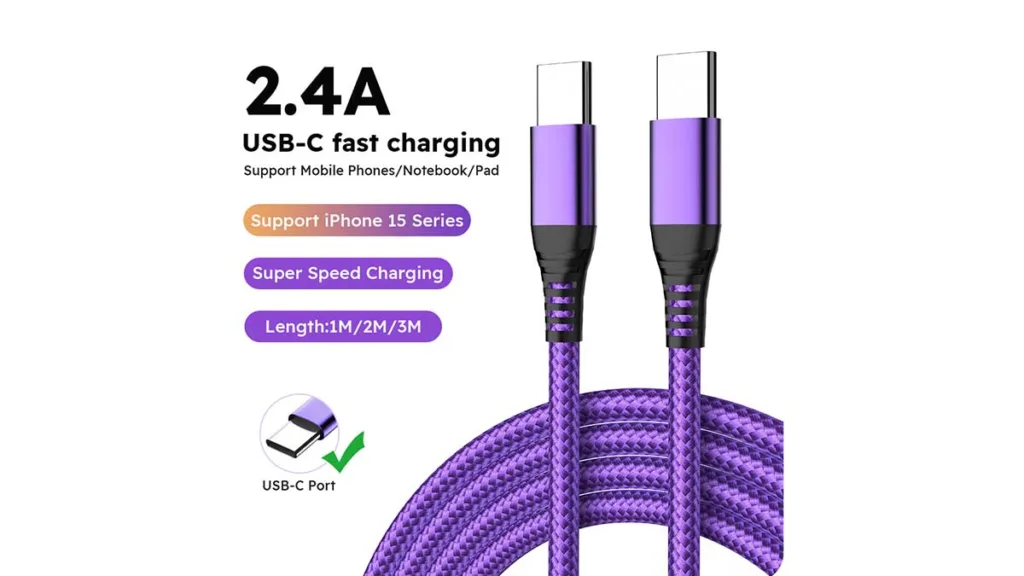In today’s digital age, data cables play a crucial role in our daily lives and work. As the link between electronic devices, they carry the crucial tasks of data transmission and charging. Whether quickly transferring photos from a phone to a computer or instantly charging a tablet, data cables are essential. It can be said that data cables have become an indispensable tool in our lives and work. Today, we will take a closer look at two common data cable interfaces: Lightning and USB-C.
Appearance
- Lightning Cable Appearance: Lightning cables are a proprietary interface designed specifically for Apple. Its connector is compact and elegant, and its size is relatively small. The cable’s connector is typically white, with clean lines, creating a clean and compact appearance. This compact design not only makes it easy to carry but also fits perfectly with the slim design of Apple devices.
- USB-C Cable Appearance: USB-C cables differ significantly in appearance from Lightning cables. Its oval-shaped connector is reversible, eliminating the need to carefully determine which way is which, unlike traditional connectors, greatly improving ease of use. The connector is typically available in a variety of colors, with black, white, and blue being common. It is slightly larger than the Lightning connector, but its overall design is more streamlined.
Performance Differences
- Transfer Speed Comparison: There is a significant difference in data transfer speed between the two connectors. USB-C cables offer a significant advantage, with a maximum transfer rate of 10GB per second. Lightning cables, on the other hand, have a relatively slow data transfer speed, with the newer Lightning USB-C ports offering a maximum transfer rate of 5Gbps. For example, when quickly transferring large amounts of high-definition photos or videos from a computer to a phone, a USB-C cable can accomplish the task more quickly.
- Charging Efficiency Comparison: USB-C cables offer a clear advantage in charging efficiency. Based on the USB 3.1 Gen 2 standard, USB-C cables can deliver up to 100 watts of power to devices (such as a 15-inch MacBook Pro laptop with an 87W charger and using a USB-C port). Lightning cables, on the other hand, have relatively low charging power.
- Because they weren’t originally designed to accommodate future high-voltage and high-current charging requirements, their charging power typically struggles to match that of USB-C cables. For example, for devices with the same power, charging with a USB-C cable will take less time than with a Lightning cable.
- Compatibility Differences: There are significant differences in compatibility between the two. The Lightning connector is Apple’s proprietary interface, primarily designed for Apple devices such as the iPhone, iPad, and iPod Touch. Connecting an Apple device to a non-Apple device may require an additional adapter or cable. The USB-C connector, on the other hand, has wider applicability. Since its introduction in 2014, it has become the standard charging and data transfer interface for a wide range of devices, including laptops, tablets, cameras, and Android phones. It’s also compatible with older USB standards, though this may require additional accessories.
Compatible Devices
- Lightning Cable Compatible Devices: Lightning cables are primarily used with Apple products. Since the iPhone 5 launched in 2012, subsequent iPhone models have mostly adopted the Lightning connector. In addition, some iPad models and devices like the iPod Touch also use this port for charging and data transfer. Furthermore, some Apple accessories, such as the Apple Pencil, Magic Keyboard, and Magic Mouse, also require a Lightning cable for connection or charging.
- USB-C Cable Compatibility: The USB-C port is widely used. In the mobile phone market, many new Android models from brands like Huawei, Xiaomi, and OPPO mostly use USB-C cables. On the computer side, modern laptops, both Windows and some new Mac models, are equipped with USB-C ports for convenient charging and high-speed data transfer. Furthermore, some tablets, cameras, monitors, external hard drives, and other devices are also becoming commonplace with USB-C cables. Even some smart home devices use this port for power and data transfer.
Usage Scenario Analysis
- Home Scenario: In the home environment, both types of cables have their advantages. If you primarily use Apple devices at home, a Lightning cable is a good choice. It offers excellent compatibility with Apple devices, provides a stable connection, and can meet the charging and data transfer needs of Apple products. Furthermore, official Apple cables are guaranteed to be of good quality. However, if your home is home to a variety of devices, including Android phones, computers, tablets, and other devices, the advantages of a USB-C cable become apparent. It easily adapts to multiple devices, allowing a single cable to meet the charging and data transfer requirements of different devices, reducing the clutter of cables.
- Office: USB-C cables are particularly suitable for office use. Office environments are home to a wide variety of devices, and data transfer between computers and devices like phones and external hard drives is often necessary. The high-speed data transfer capabilities of USB-C cables can greatly improve work efficiency, for example, by quickly transferring large files from a computer to an external hard drive. Furthermore, many modern office computers are equipped with USB-C ports, Actively charge your laptop, reducing desktop cable clutter. Lightning cables, on the other hand, are primarily designed for Apple devices. While they can meet charging and data transfer needs for Apple computers and iPhones, they are limited when interacting with non-Apple devices.
- Travel: The convenience of USB-C cables is particularly evident when traveling. When traveling, you might be carrying a variety of devices of different brands and types, such as Android phones, tablets, and cameras. The wide compatibility of USB-C cables allows you to use a single cable to charge and transfer data across multiple devices, reducing the number of cables you need to carry. Furthermore, USB-C charging facilities are increasingly available in public places, such as airports and train stations. However, USB-C cables are relatively bulky and can take up considerable space when carried. Lightning cables, on the other hand, provide stable connections and charging if you’re only carrying Apple devices, but they won’t work if your companions use non-Apple devices, requiring you to carry additional cables.
Summary and Recommendations
- Key Differences: As mentioned above, Lightning and USB-C cables differ significantly in several aspects. In terms of appearance, the Lightning connector is compact and elegant, while the USB-C connector is oval and slightly larger. Both are reversible. In terms of performance, USB-C cables offer advantages in transfer speed and charging efficiency, with a maximum transfer rate of 10GB per second and a charging power of up to 100W. Lightning cables offer relatively lower transfer speeds and charging power. In terms of compatibility, the Lightning connector is Apple’s proprietary interface, primarily used with Apple devices. The USB-C connector is highly versatile and compatible with a wide range of device brands and types.
- Suggested Selection: If you’re a dedicated Apple device user, primarily using iPhones and tablets, a Lightning cable will meet your basic needs and offer excellent compatibility and a stable connection. However, if you have a diverse device portfolio, including Apple, Android, and computers, or require high data transfer speeds and charging efficiency, a USB-C cable is a better choice. It allows you to use a single cable for multiple devices, improving convenience and efficiency.
If you need our product catalog, please contact us:Product Catalog



